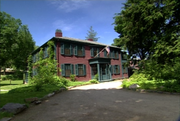We're visiting the Vassall-Craigie-Longfellow house.
All of you have heard about Longfellow, the poet.
Who wrote among many other things "The Midnight Ride of Paul Revere".
It's known as the Vassal house because the builders in the mid Georgian period, mid 1700s, were loyalist colonist's who fled here, at the beginning of the Revolution, leaving all their properties, leaving the silver on the table.
Now the house was headquarters for General George Washington .
In fact, this was all open land back then and his troops were encamped here along the land surrounding the house.
Longfellow, our great poet, was one of the early preservationists.
And he was fortunate to be married to a woman who was an heiress.
And it was the, the father-in-law who founded the, the woolen mills here in New England.
Who gave them this historic house as a wedding gift.
And they proceeded, during their lifetime, to kind of recreate and to create an archive and to really be preservationists This in the 19th century.
The house was also a magnet for intellectuals from all over America and the world, who came here to visit with Longfellow, the great American intellectual.
We want to take our tour inside with the fellow who is the manager and curator here.
This is a house that belongs to the National Park Service and his name is Jim Shay.
Let's go inside.
Hi Jim.
Hi Bob.
Welcome to the Longfellow house.
Thank you.
You know, a house like this, I don't know whether to start talking about the architecture or start asking questions about the history.
Well obviously, architecture is the most obvious and you look at the staircase, it's so wonderful, which dates to the building of the house in 1759.
And is it a double staircase?
It is, it's one of a double staircase, the front is the most decorative and the back is one place people come up to.
But it's also an art gallery in here.
Well you see obviously we have people like George Washington who actually lived in this house, and that shows the layers of history since he was one of the residents.
Here.
He lived in in 1775.
And, Longfellow the poet tried to create a shrine to General Washington here, right?
He did.
Washington lived here from 1775 to 1776.
So when Longfellow lived here in 1843, he created a shrine for Washington with the bust and paintings of the house.
Was this the poet's study?
Yeah, come on in.
The... Mr. Longfellow actually wrote most of his poetry and prose in this room.
And as you come through you see Mr. Longfellow himself, right here.
So this is a room that's kind of the typical of the 1860s?
1860s , 1870s.
This is typical of , you know, this neighborhood.
And, and when you look at the colors in here, the bright red drapes and the taupe walls and everything it could be, you know, it could be contemporary.
Definitely, definitely, and this...
Is this a portrait of Longfellow?
This is Mr. Longfellow.
It was painted in his later life, of course.
It was done by his son Ernest Longfellow.
Amazing.
Tell me a little bit about the furniture.
What about a chair like this Hey this chair is actually wonderful.
It has a great story to it as many things as many things in this house do.
But this particular chair was built from the wood of the spreading chestnut tree.
Mr. Longfellow wrote a poem called "The Village Blacksmith".
Yeah.
And in 1876 the tree was chopped down.
It used to be on Bridal Street here.
Which saddened Mr. Longfellow so much.
So the children of Cambridge pooled their money and had the wood from the tree made in this chair.
Designed by Longfellow's nephew W.P.T Longfellow.
Really?
Yeah
That's a great story.
This is actually the spreading chestnut tree here in the blacksmith shop.
In this picture.
In this picture, is painted by Voltan, the artist in 1846.
Fabulous story.
Now, was this the actual library, I mean I heard he was a a collector of books?
His library actually is ten thousand volumes, so follow me because the library is actually in the next room.
OK, so this was the working room and then the actual library was next door.
Exactly, exactly.
Well its clearly a library, but it also has the feel of a very, very Gracious living room.
You're right.
And we do have all these books from Mr. Longfellow.
He spoke several languages and could read twelve.
Really?
Yes.
And also, we have around the house paintings and sculpture, work from Italy, from all of the world.
So, they did the grand tour of Europe?
The grand tour of Europe, of course.
And over here, we have some ceramics from Japan, French bronzes, a clock from France, as well.
Yeah.
Now how was the room used?
Just a repository for books?
The room was used as a music room, actually.
And reception for people from around the world.
We had people like Jenny Lind coming here.
The opera singer.
Yeah.
Oscar Wilde came here.
Charles Dickens was often here.
It's a fabulous piano, too, isn't it?
Yes, yes.
The piano was actually Alice Longfellow's piano.
And Mr. Longfellow, himself, could play the piano.
Mm-hm.
Now the room is an 18th century room with all this grand paneling.
And the moldings, and the dentils, and this mantelpiece.
is it from the original 1759 construction?
No, it's not.
This actually came from another house called the Old Boot House in Boston.
Demolished in 1846 and Mr. Longfellow brought this mantle to this house and had it installed.
But, it's from the 1700's.
Exactly.
So, he was collecting items from the previous century that fit into the house.
The layers of history here.
Right.
Exactly.
Where to next?
Why don't you follow me to the back hallway?
OK.
Boy, the books are amazing, huh?
Jim, why would a Georgian mansion like this have a front stairs and a back stairs.
It's clearly not a service staircase, they're both very elaborate.
Right, actually, public space and private space being -- this being for the family, coming back here.
But thevisitors would not use this space at all.
So, this is kind of private.
Exactly.
I see.
And this is the formal dining room.
Yeah, the dining room .
And is the table set for dinner?
No, actually it's set for dessert table.
All the original artifacts from the Longfellow family, as you see around this room.
Including the paintings and this Buddhist alter table.
What is this?
A Buddhist altar table that the older son Charles Longfellow brought back from Japan in 1870.
All red lacquer.
Red lacquer.
Quite a souvenir to bring back.
Yeah, he actually brought back trunks and trunks of this from Japan and China.
Now who are the lovely women on the wall?
Okay, we actually have Fannie Appleton, Henry Longfellow's wife.
His three daughters, right here, and Mary Appleton, which is Fannie's sister.
So they were the two heiresses to this huge textile fortune, right?
Yes.
Exactly.
And Fannie's parlor was supposed to be quite famous.
Right, and come and see it.
OK.
Boy, what an extraordinary room, huh?
This is really high Georgian detailing.
The, the overmantel and the mantel flanked by the arching doorways.
And the pilasters, this is all... woodwork that's all hand-planed and carved, broken pediment at the top.
What a fabulous room.
Yes.
This is probably the fanciest room in the house.
It's wonderful.
It is.
It is.
Now, the furnishings certainly don't look 18th century though.
No, they're not.
They're [unintelligle] Henry Longfellow and Fannie Longfellow.
And we have furniture and paintings from that period.
What year did they move into this house?
1843.
So, this is when they decorated this room.
Exactly.
And this actually the original wall paper from 1846 that Fannie choose and put in the room here.
And the room was never changed?
Never changed, nope.
And she died tragically in a fire in this house.
And this is a memorial to her from Henry Longfellow.
So, the family maintained the room as she had it.
Kind of in her memory.
Exactly.
Exactly.
How wonderful.
You know, also, Martha Washington lived here.
And this a portrait of her.
And this also Martha Washington's parlor, which we have preserved.
And Fannie Longfellow also was --
There is that real connection between the Washington's and the Longfellow's and the whole spirit of preservation in this house.
Exactly.
Now tell me, Jim, the National Parks Service owns the house.
Is it open year round?
It is not.
Right now, we're closed six months out of the year.
We're open May to October of every year, and we'll be opening soon, actually.
And I know there's a group called The Friends of The Longfellow House who are doing a lot to raise funds for preservation and improvements here at the house, right?
Right.
They're an important group right now, community-based, and we look forward to working with them for many years.
Marvelous.
Well, thank you for the tour.
Okay.
It's a very special house.
Thank you.
We have to break for some messages.
When we come back, we'll be back at our house.
Don't go away.







